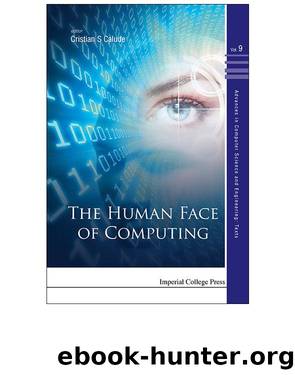The Human Face of Computing by Cristian S Calude

Author:Cristian S Calude
Language: eng
Format: epub
Publisher: Imperial College Press
Published: 2015-08-04T00:00:00+00:00
1For more on the history and development of parameterised complexity, one should have a wee look at the Festschrift volume for Mike Fellows LNCS 7370, particularly for the role of Mike Langston who was there from the start.
2Specifically, usually this assumption will be M[1] â FPT, which is equivalent to the ETH, n-variable 3SAT is not in DTIME(2°(n)).
3The paper won the 2010 Shoenfield Prize for writing in logic.
Chapter 15
Jozef Gruska: Informatics, Physics and Mathematics
Professor Gruska, http://www.fi.muni.cz/usr/gruska, is well known not only for his results but also because he has been âeverywhereâ â heâs had 33 long-term visiting positions in Europe, North America, Asia and Africa. He introduced the descriptional complexity (of grammar, automata and languages) and is one of the pioneers of parallel (systolic) automata. Professor Gruska is the cofounder of four, regular series of conferences on informatics and two in quantum information processing, and the founding chair (1989â1996) of the IFIP Specialist Group on Foundation of Computer Science.
He has been awarded my distinctions including Computer pioneer (IEEE, 1996), the Bolzano medal of the Czech Academy of Sciences (2003), elected member of the Academia Europaea (2006), Doctor Honoris Causa, Latvian University (2013), IFIP Silver Core Award (1995) and Slovak Literally Fond Awards (1998, 2000).
His other research interests include parallel systems and automata, and quantum information processing, transmission and cryptography.
CC: A century ago hardly anyone would consider information an important concept for physics.
JG: Correct. One can even say that at that time one could hardly see information as a scientific concept at all. In spite of the fact that quantum entropy had been known since 1932, and actually before classical entropy, it was only due to the seminal work of Shannon, A Mathematical Theory of Communication, in 1948, that (hard) science started to see the concept of information as a scientific one.
CC: Shannonâs concept is very important, but it does not fully capture the intuitive concept of information. There are many other models for information (a âWorkshop on Information Theoriesâ was held in Münchenwiler, Switzerland, in May 2006).
JG: I think philosophers still consider the concept of information as one we have no full understanding of yet. Historically, they see its origin from the Latin words informatio and informare. In scholastic terms one would see information as a representation of matter through a form. Information usually has three dimensions: syntactic, semantic and pragmatic. An important philosophical approach to this concept was developed by Carl Friedrich Weinzsäcker in Information is das Maβ eine Menge von Form â¦; it comes from his Ur-theorie.1 There is lots of interesting material written about information from the point of view of philosophers, but hardly anything âreally usefulâ. Shannonâs approach, motivated to a significant extent by war problems, considers âonlyâ quantitative aspects of information, from the point of view of transmission, as a key ingredient of communication. This semantic-less concept has turned out to be extremely important and one of the success stories of modern (applied) mathematics.
CC: My colleague, Garry Tee, pointed out to me that Edmond Halley
Download
This site does not store any files on its server. We only index and link to content provided by other sites. Please contact the content providers to delete copyright contents if any and email us, we'll remove relevant links or contents immediately.
Algorithms of the Intelligent Web by Haralambos Marmanis;Dmitry Babenko(16236)
Jquery UI in Action : Master the concepts Of Jquery UI: A Step By Step Approach by ANMOL GOYAL(9389)
Test-Driven Development with Java by Alan Mellor(7736)
Data Augmentation with Python by Duc Haba(7610)
Principles of Data Fabric by Sonia Mezzetta(7380)
Learn Blender Simulations the Right Way by Stephen Pearson(7296)
Microservices with Spring Boot 3 and Spring Cloud by Magnus Larsson(7139)
Hadoop in Practice by Alex Holmes(6589)
RPA Solution Architect's Handbook by Sachin Sahgal(6519)
The Infinite Retina by Robert Scoble Irena Cronin(6217)
Big Data Analysis with Python by Ivan Marin(5936)
Life 3.0: Being Human in the Age of Artificial Intelligence by Tegmark Max(5518)
Pretrain Vision and Large Language Models in Python by Emily Webber(4896)
Infrastructure as Code for Beginners by Russ McKendrick(4654)
Functional Programming in JavaScript by Mantyla Dan(4438)
WordPress Plugin Development Cookbook by Yannick Lefebvre(4384)
The Age of Surveillance Capitalism by Shoshana Zuboff(4249)
Embracing Microservices Design by Ovais Mehboob Ahmed Khan Nabil Siddiqui and Timothy Oleson(4149)
Applied Machine Learning for Healthcare and Life Sciences Using AWS by Ujjwal Ratan(4136)
